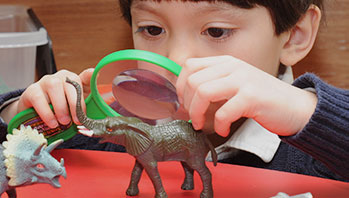- slices of fruits and vegetables in a variety of shapes and colors (real, plastic or laminated images if real vegetables are not available)
- strips of paper
- fruit
- pattern
- vegetable
MA Standards:
Mathematics/Counting and Cardinality/PK.CC.MA.4: Count many kinds of concrete objects and actions up to ten, using one-to-one correspondence, and accurately count as many as seven things in a scattered configuration.
Head Start Outcomes:
Logic and Reasoning/Reasoning and Problem Solving: Seeks multiple solutions to a question, task, or problem.
PreK Learning Guidelines:
Mathematics/Patterns and Relations 9: Recognize, describe, reproduce, extend, create, and compare repeating patterns of concrete materials.
Fruit and Vegetable Patterns

© Commonwealth of Massachusetts, Department of Early Education and Care (Jennifer Waddell photographer). All rights reserved.
Skill Focus: Math (Counting, Patterns), Vocabulary
Educator Prep: Cut slices of fruits and vegetables to be used in pattern making. You may want to slice some extra pieces for snacking as children create patterns.
Safety Tips:
- Be aware of any child’s dietary needs and allergies before beginning the activity.
- Remind children to wash their hands before and after the activity.
Have children make patterns on their paper strip with slices of fruits and vegetables. Guide them to start at the left-hand side. Demonstrate by starting an A-B-A-B pattern (e.g., carrot, pepper, carrot, pepper) and have children repeat the pattern. Then challenge them to extend the patterns. Encourage children to create new patterns and to experiment with different fruits and vegetables. As children work, encourage them to count the number of fruits and vegetables in their pattern. You may want take a photo of each pattern to send home with children; then create a group pattern book to keep in the Science and Math Center.
Adaptation: For children with strong patterning skills, challenge them to create different patterns (e.g., A-A-B-A-A-B; A-B-B-A-A-B-B-A; A-B-C, etc.). Pair children and have them repeat one another’s patterns.
